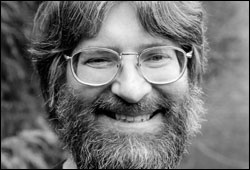MATT KOCMIEROSKI has built a fortress of instruments in his low-ceilinged basement studio. Leaving just enough space to squeeze in, he’s surrounded himself with percussion: a vibraphone, chimes, a tall frame hung with gongs, two timpani, tom-toms and drums of every size, cymbals, and a tableful of woodblocks and Latin percussion. He’ll need to re-create this setup on the stage of St. Nicholas Hall to play Bun-Ching Lam’s L as part of the Seattle Chamber Music Society’s Summer Festival (7 p.m. Monday, July 21, at Lakeside School, 206-283-8808).
Each SCMS recital (preceding the 8 p.m. main concerts) is handed over carte blanche to a musician or twoa half-hour to program as he or she will. Artists get to share their personal enthusiasms, resulting in some of the festival’s most engaging performances and interesting repertory. Lam’s captivating soundscape should be a superb introduction to percussion music for those who may not have experienced it in a solo setting.
There’s no standard procedure for the multitude of possibilities open to percussion composers, either for the physical setup of the instruments or for the score layout: You have to, as Kocmieroski puts it, “design a palette, and then design a notation.” When Lam wrote L (which translates as “woman that roams”) for Kocmieroski in 1983, she used what was his entire percussion collection at the time, divided according to medium: wood, metal, skins. Her piece had to be choreographed just to ensure that every instrument in the collection is physically reachable when needed.
“Logistics are a big part of it,” Kocmieroski explains. “You learn to do a lot of air practicing.” L‘s high point in this respect is the third movement, “Travel,” which requires Kocmieroski to dash around the setup with acrobatic precision.
L opens sparsely with a movement titled “Preparation,” just a few delicate clicks from the temple blocks. Gradually, the metals enter, climaxing in “Emerge” and “Travel” in brilliant, roaring washes of sound. “Offer” features the vibraphone, not played with mallets but stroked with double-bass bowswith no audible mallet-on-bar attack sound, the ethereal tones seem to coalesce magically out of the air. “Collect” spotlights the glissando possibilities of the pedal timpani. And for the transcendent finale, “Sacrifice,” cymbals and crotales (small pitched cymbals) are set on the timpani, gently dinged as the drumhead they rest on is tightened and loosened to make heady “underwater” pitch-bending effects.
Chamber music that includes percussion is rare enoughat this festival in particular, which has traditionally shied away from contemporary music. The appearance this season, though, of a notable amount of post-WWII works is heartening. The SCMS is coming to realize that its audiences can tolerate, even welcome, a little novelty when played by musicians like Kocmieroski: passionate advocates for the unfamiliar.







